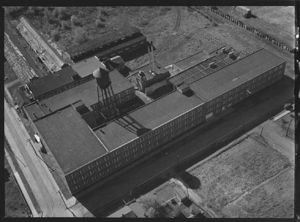The Farnsworth Building
Contents
Early Years
The project was set up to erect a group of buildings on the then empty farmland at 38th and Adams. The buildings were to be used in manufacturing radios for sale across the country. The first company to actually occupy the building was Indiana Electric Company; they used the facilities to produce rear view mirrors, and candlestick holders (Marion Plant History). In 1928 the property changed hands to Case Electronics, which began the radio manufacturing business on the site (Marion Plant History). In 1929 the property changed hands yet again, when Case Electronics merged to become U.S. Radio and Television Corporation (Marion Plant History). In 1932 U.S. Radio acquired another corporation, Grunow Radio (Marion Plant History). The final acquisition for the next ten years was by Farnsworth Television and Radio; the corporation purchased both the Marion plant and the Capehart factory of Fort Wayne (Marion Plant History). The Farnsworth ownership was short lived, changing hands to RCA in 1948 (Marion Plant History). At that time the radio was the cutting edge in the entertainment industry, and the business picked up well, in the first years it made less than five thousand radio sets, which was good for the era.
Farnsworth in World War II
RCA
Antitrust Breakup
In twenty more years the RCA, Thomson, Westinghouse, and GE, company broke apart; the break was due to government findings that the corporation was considered a “trust” or illegal business grouping which has the corner on many facets of the nationwide market. Due to the break, Elihu Thomson took the Thomson/GE Corporation to Europe, where he began a successful venture into medical electronics (Smith, personal interview). With the Thomson/GE part of the corporation went the beloved dog icon.
However, at the time the occurrence did not really seem to hurt the RCA business. RCA/Westinghouse stayed in the U.S., in the research and development technologies business. The RCA Corporation developed color television, and later in their ventures developed VHS, video game consoles, Laser disc, Compact Disc technologies, and new larger screen more compact televisions (Smith, interview). However between 1985 and 1990 GE, headed by Jack Welch, took over the American RCA name (Vodraska, personal interview).
Sale to Thompson
The GE merger didn’t go over well in Marion, with many changes being made. GE sold RCA to the now separate Thomson Corporation, a subsidiary of the French national government corporation, after only a short time at the corporate helm. Under the guidance of Thomson the Marion RCA plant has increased its product greatly, from 9000 in 1976 to 15000 in 1990. 1990 was the low point in employment, with eight teen hundred employees, however due to the automation of Thomson, the amount of quality product was nearly doubled, due to Thomson’s automation of the Marion plant (Thorne/Smith, personal interviews).
While under the RCA name the Marion factory has had great community involvement. They held corporate softball leagues from nineteen fifty-six until the early eighties, and have been a major sponsor to the Marion Philharmonic Orchestra throughout its run (Smith, personal interview). The RCA Corporation gave back to the community through its employees. It has held company picnics in Matter Park annually, and has sponsored statewide sporting events, such as the RCA tennis tournaments in Indianapolis, and sponsoring the RCA Dome (Smith, personal interview). The company has also given back to Marion in a grand way; the employees of Thomson recently donated a new wing to the Marion General Hospital in the name of the first plant manager Linn Gillen (Smith, personal interview). RCA’s overall involvement has lead to a highly regarded community reputation on a corporate level.The Farnsworth Building Today
The original Farnsworth Radio building still houses a large part of the Marion television making facilities it serves as a modern day test lab for the quality control engineers, it also houses a tube life testing section (Vodraska, personal interview). The building is now filled with various pieces of test equipment and with loading skids full of test tubes--the cutting edge of technology for the business in the building, the same way it was in the late eighteen hundreds and early twentieth century when Farnsworth owned it. However, the main architectural points still show well. The lattice work archway in building fifteen is a main point of interest from an architectural standpoint. The latticework and laminated beams support a very interesting curved roof, which signifies well the old part of the building. The oldest parts of the the Farnsworth building show the great workmanship and engineering that was used to create them. They have been in place for over fifty years as RCA, and another thirty as Farnsworth, these testaments to workmanship show how well constructed the old Farnsworth building was.
Works Cited
- Smith, J.D. Personal Interview. 2 January 2001.
- Thorne, Bill Personal Interview. 22 December 2000.
- Vodraska, James Personal Interview. 28 December 2000
- “On the Expansion of Marion.” Chronicle Tribune 27 February. 1966: vertical file
- “Marion Plant History,” Marion Public Library date unknown: vertical file
- RCA. Marion: The first 195 Days, 1999
- “Untitled.” Chronicle Tribune 12 January. 1992:




